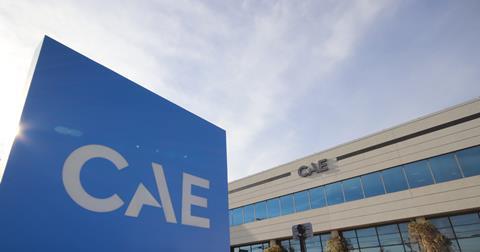While a largely grounded and cash-strapped airline industry was weighing up its future during the dark days of the pandemic, CAE was busy quietly laying the foundations for an ambitious post-Covid departure into the digital world. A trio of acquisitions between late 2020 and early 2022 saw CAE establish its Flight Operations Solutions arm, expanding its reach from its core market of aviation training into real-time operations.

The Canadian company’s purchases of RB Group, maker of an app-based rostering tool for pilots; crew management software specialist Merlot Aero; and Sabre’s AirCentre business set CAE on a journey to unite operators and crew in a single, interconnected digital ecosystem.
Since its foundation shortly after the Second World War, CAE has been an innovator, consistently making bold moves to meet the changing needs of the market. The shift into airline operations echoed Montreal-based CAE’s last big strategic pivot – two decades earlier – when it broadened its scope from its traditional activity of manufacturing simulator devices into services to become within a few years the global leader in airline pilot training. That transition completely altered the market perception of CAE, turning airlines from purchasers of its capital equipment to long-term training partners.
Pascal Grenier, who is CAE’s Division President, Flight Solutions, and has been with the company for 25 years, is confident this latest initiative will be as significant as the move into training services. “When we pivoted to become a training provider, we had to demonstrate to airlines the value CAE could bring, and we succeeded. It’s the same with Flight Operations Solutions. In an incredibly competitive market, airlines are looking for cost and operational efficiencies, and CAE is developing and delivering innovative solutions that address their needs.”
With the three acquired technology businesses rebranded under the Flight Operations Solutions banner, CAE now offers its cloud-based digital products in five areas: flight management, crew management, operations control, airport management, in-flight services management, and its just-released Unified Task Board which draws information from these systems to identify disruptions and help operations control teams make more informed decisions across domains.

Flight management – ensuring the optimal routing of an aircraft – is a crucial component of flight operations that requires constant input and adjustments.
The Flight Plan Manager tool allows operations teams to analyze options for an entire fleet in a single view, while they can track and monitor individual aircraft with Flight Explorer. The latter includes position data to ensure compliance with GADSS (global aeronautical distress & safety system) and provides graphical weather options. eFlight Manager brings pilots into the loop by transmitting data gathered from Flight Explorer and Flight Plan Manager directly to the flight deck.
Your Airbus A350 captain takes ill just before a flight. Is there a relief pilot available and what impact will bringing him or her on duty have on tomorrow’s schedule and pilot roster? The Crew Management solution merges advanced technologies to help customers optimize schedules, forecast crew resources, and recover rapidly from disruptions, including broken pairings.
A sister product, Crew Access, available on mobile devices, gives pilots and cabin crew real-time, cloud-enabled information about their roster schedule. A chat function enables better communication between employees, including helping them to manage their life beyond the airport with ease.
Operation control centres are the brains of an airline when it comes to coordinating real-time movements. But teams typically work in silos, not necessarily communicating at the crucial point, before a problem manifests itself. CAE’s Movement Manager tool allows team leaders to keep an eye on all the moving parts through a single view, enabling situational awareness and reducing the risk of duplicating efforts or human error. The tool is also available as a mobile app.
With Flight Operations Solutions CAE has also entered the airports market – or at least the airport side of an airline’s operations, including gate allocation and ground crews. The Airport Management tools include algorithm-powered software to plan staff resources and manage them in real time via a mobile app. The app can also be used by ground crew and gate staff to view their schedules, request time off, and record absences.
CAE has even moved into in-flight catering, a crucial aspect of any long-haul airline’s operational priorities and brand reputation – as any cabin crew member who has had to explain to an irritated passenger why there are no vegetarian options left will attest. The In-Flight Services Management tools help airlines plan for and manage everything from no-shows to special meal requests, as well as making sure the right meals arrive on time at the right gate. A machine learning algorithm forecasts passenger demand to reduce waste.
When weather, maintenance or other delays throw a wrench into an airline’s operations, CAE’s newest solution, Unified Task Board, is ahead of the game, consolidating information from various systems to proactively identify possible disruptions and generate recovery scenarios - all in one view. Unified Task Board heightens OCC staffs’ situational awareness of the whole operation to efficiently manage disruptions through simple, fast and contextual collaboration.
According to Grenier, CAE’s foray into the operations environment with its suite of digital tools has disrupted the market by creating the first true industry-wide digital ecosystem. The company’s reputation as a technological innovator and a business that airlines can trust has made that transition easier. “CAE is an amazing brand that is appreciated by its customers for our customer-centric approach in everything we do,” he says. “What we have done is take this culture and applied it to a different part of the industry, but where we are still dealing with the same customers.”
When it comes to the technology itself, Grenier acknowledges that there is still wariness in some circles about AI and whether it can replicate or enhance the work of experienced professionals. However, he maintains that the complexity of modern airline operations means it is impossible for individuals, no matter how skilled, to weigh up a host of options and possible outcomes instantly. “Only AI can run multiple scenarios, including those that say your choice is okay for today but will have certain implications downstream,” he says. “It is very difficult for a human being to take these sorts of decisions.”

Flight Operations Solutions, he says, is not necessarily about a piece of software making the right or wrong decision, but about optimisation. “All these solutions are about coming up with the optimal solution, whether that is the least cost, or the least impact on passengers, or the least effect on the airline down the line, or a combination of all these,” he adds.
The reception so far to the new business venture has been “great”, says Grenier, with four in five existing CAE customers taking up at least one of the Flight Operations Solutions products. However, CAE has also secured airlines who have not bought its training services or equipment in the past, “so we have extended our customer base”.
Ultimately, he maintains, CAE’s backing of the industry during Covid-19 is partly why customers have been so receptive to the move. “We supported airlines through the difficult times,” he says. “Now they are staying with us as we take the next step in our evolution.”























